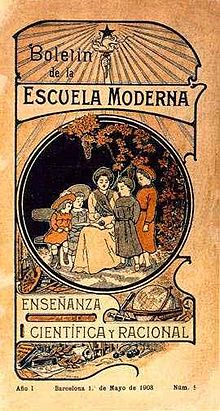Escuela Moderna

La Escuela Moderna (Spanish for "The Modern School") was a progressive school that existed briefly at the start of the 20th century in Barcelona (Spain).
Founded in 1901[1] by free-thinker Francesc Ferrer i Guàrdia, the school's stated goal was to "educate the working class in a rational, secular and non-coercive setting". In practice, high tuition fees restricted attendance at the school to wealthier middle class students. It was privately hoped that when the time was ripe for revolutionary action, these students would be motivated to lead the working classes.
It closed in 1906. Shortly after, Ferrer was executed for sedition.[1]
Today, the only remaining archives from the school are held in the special collections department of the University of California, San Diego.[2]
La Escuela Moderna, and Ferrer's ideas generally, formed the inspiration for a series of Modern Schools in the United States,[1] Cuba, South America and London. The first of these was started in New York City in 1911. It also inspired the Italian newspaper Università popolare, founded in 1901.
References
- ^ a b c Geoffrey C. Fidler (Spring–Summer 1985). "The Escuela Moderna Movement of Francisco Ferrer: "Por la Verdad y la Justicia"". History of Education Quarterly. 25 (1/2). History of Education Society: 103–132. doi:10.2307/368893. JSTOR 368893.
- ^ "Finding Aid redirect". libraries.ucsd.edu. Retrieved 2015-12-18.
